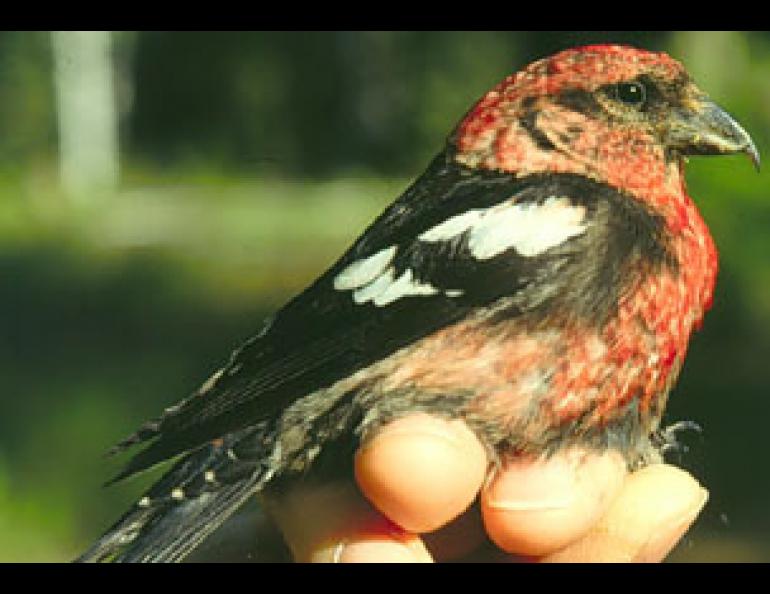
Winter Ways of the White-Winged Crossbill
Near a wood stove was a good place to be this past week, as temperatures in this part of Alaska dipped to minus 40. The cold and the ice fog kept most humans indoors, but Alaskans across the state from Prudhoe Bay to Ketchikan got out for a bird count sponsored by the National Audubon Society. Bird watchers here in Fairbanks found the woods heavily sprinkled with redpolls; out of almost 10,000 birds seen by the 92 volunteers, more than 7,000 were redpolls.
While gangs of redpolls gobbled birch seeds, another bird with an appetite for tree seeds--the white-winged crossbill--was hard to find. Fairbanks spotters saw just 38 white-winged crossbills this year, compared to 830 in 1994 and none in 1995. Anchorage volunteers noticed the same pattern; they saw just six white-winged crossbills in 1995, 580 in 1994, and 28 this year.
The birds boom and bust in Alaska because white and black spruce trees do not sprout cones every year, and white-winged crossbills feed almost exclusively on spruce seeds. The birds are so linked with the spruce of the boreal forest that they may even time their breeding so their young are hatched in a time of plenty. People outside Alaska have seen white-winged crossbills sitting on nests in the middle of winter in areas where spruce trees are rich with cones. Other bird species mate only in spring and early summer.
Pierre Deviche, a researcher at the Institute of Arctic Biology at the University of Alaska, wondered whether white-winged crossbills would use this opportunistic breeding ability in Alaska. Sure, spruce trees here might produce lots of cones, but does it make sense to lay eggs when it's 20 below and the night lasts 20 hours?
To see if the white-winged crossbills act differently in Alaska, Deviche checked the age and sexual maturity of more than 450 birds during a study that lasted two-and-a-half years. During that period, spruce trees had at least one season of what foresters call a good cone crop, when the tops of trees droop with the weight of cones and all is well for the crossbills. Deviche saw that despite the abundance of food, the white-winged crossbills did not mimic their counterparts farther south by breeding in seasons other than spring and early summer.
Why not? Deviche thinks cold weather and short days combine to make the success of winter breeding unlikely. Though white-winged crossbills construct snug nests of moss and lichen, cold air temperatures would require either the male or female bird to sit on the eggs constantly. The other parent would have to feed itself, its mate, and, after the hatch, the young birds. White-winged crossbills are not particularly early risers, Deviche said, and four hours of daylight would probably not be enough time for one bird to gather enough food for its family, especially on extremely cold days when the birds' energy needs would be higher.
Apparently, the rigors of an Alaska winter force the white-winged crossbill to adopt other birds' breeding patterns, which seem to be triggered by day length. The moral of this tale: you can't mess around during Alaska's winter.
To those who followed my trans-Alaska pipeline hike this summer: Jane is well, thanks. She's at home, sleeping on the couch by the wood stove, woofing at the dream image of three bears in a spruce tree. My thanks to Carla Helfferich for pinch-writing the science forum columns a bit longer than she expected, and to my boss and the higher ups at the Geophysical Institute who gave me time off to get a head start on my book about the people I met this summer.





